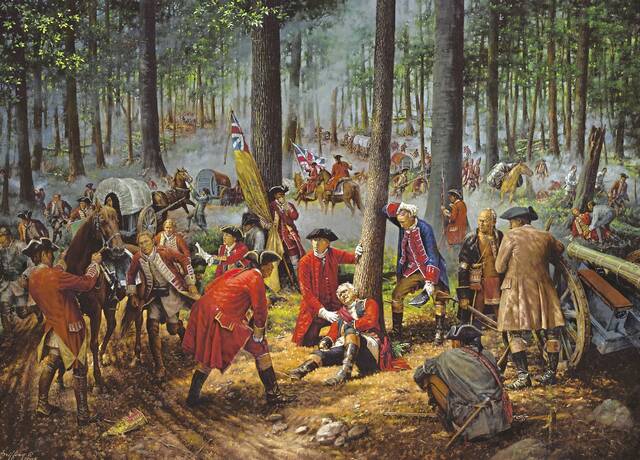https://triblive.com/local/westmoreland/a-generals-defeat-anniversary-will-be-observed-in-north-braddock/
A general's defeat: Anniversary will be observed in North Braddock

At the eastern edge of Westmoreland County’s Route 30 corridor lies one of the state’s best example of a colonial fort — Fort Ligonier, the site of the October 1758 battle where British and Colonial forces repulsed an attack by French and Native Americans.
But it may not have been built if British Gen. Edward Braddock had been successful in capturing Fort Duquesne in July 1755.
Instead, Braddock’s troops suffered a devastating defeat at the hands of the French and Native Americans when they clashed July 9 in the woods of present-day Braddock and North Braddock.
“The cataclysmic battle with global implications … was a victory by the Native Americans,” said Shawn MacIntyre, the public engagement and operations manager at Braddock’s Battlefield History Center in North Braddock.
There were roughly 250 French coupled with 650 Native Indians whose prowess carried the battle against some 1,500 British and Colonial troops, routing the larger force. Indians from some 20 tribes and communities joined with the French to confront advancing British and Colonial troops after they crossed the Monongahela River.
The battle, part of a global conflict in Canada, the British colonies and Europe, was observed this weekend with activities at the Braddock’s Battlefield History Center at 609 Sixth St. There will be firing demonstrations, living history interpreters and children’s activities provided by the Braddock Youth Project at the center, which stands just south of site of the initial confrontation between the opposing forces.
Had the battle turned out differently, there would never have been a need for the British to launch a campaign across Pennsylvania to dislodge the French, said Matt Gault, education director at Fort Ligonier and Braddock’s Battlefield History Center.
Fort Ligonier was built in the fall of 1758 on a hillside above Loyalhanna Creek to support British Gen. John Forbes’ campaign across Penn’s Woods to lay seige to the French fortification Fort Duquesne at the forks of the Ohio during what is referred to in the United States as the French and Indian War.
But George Washington had wanted Forbes’ troops to proceed from a fort at present-day Bedford down to Fort Cumberland in Maryland, where they would follow Braddock’s road to Fort Duquesne, Gault said.
“Washington saw it as the best opportunity to move the army forward” on a road cut three years earlier, Gault said.
Forbes, however, sent Col. James Burd forward across the Alleghenies from Bedford, then known as Raystown, to construct a fort along the Loyalhanna, which went by the name of Loyal Hannon in Forbes’ writings. Burd reached the site in late September and began the construction of the fort. Washington’s Virginia troops still were Fort Cumberland and did not arrive at Fort Ligonier until November, Gault said.
Copyright ©2025— Trib Total Media, LLC (TribLIVE.com)
